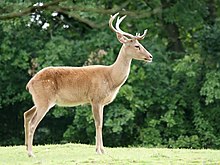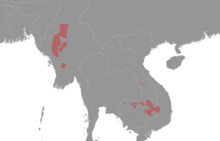Eld's deer
| Eld's deer | |
|---|---|

| |
| Burmese brow-antlered deer at Chester Zoo | |
| Scientific classification | |
| Domain: | Eukaryota |
| Kingdom: | Animalia |
| Phylum: | Chordata |
| Class: | Mammalia |
| Order: | Artiodactyla |
| Family: | Cervidae |
| Subfamily: | Cervinae |
| Tribe: | Cervini
|
| Genus: | Rucervus Pocock, 1943 |
| Species: | R. eldii
|
| Binomial name | |
| Rucervus eldii (McClelland, 1842)
| |

| |
| Synonyms | |
| |
Eld's deer (Rucervus eldii or Panolia eldii
Taxonomy
The species was first described by
The three subspecies of the Eld's deer are:[2]
- R. e. eldii: Nominate subspecies. The Manipuri brow-antlered deer is found in Manipur, India. It is called the sangai in Meitei.
- R. e. thamin: The Burmese brow-antlered deer found in Myanmar and westernmost Thailand.
- R. e. siamensis: The Thai brow-antlered deer is found in in 1915.
Appearance
The following measurements have been reported for the Eld's deer:[14][15][16][17]
- Head–body length: 150–180 cm (59–71 in)
- Shoulder height: 110–125 cm (43–49 in)
- Tail length: 20–30 cm (8–12 in)
- Weight: 125–175 kg (276–386 lb)
- Antler length: 99 cm (39 in)

The deer are generally of medium size and are similar to the size and shape of the related
Conservation status
The conservation status of three subspecies of Eld's deer, by country, are:

India
The
" 'Thanks to these youngsters who live nearby', he said. I was happy and felt indebted to the youngsters for saving our lives. My friend added that these people really loved and respected the Sangai deer. They believed that killing the Sangai was an unpardonable sin. According to a Meitei legend, the Sangai are the link between humans and nature. So, killing us would mean breaking a bond. My friend informed me that people concerned about animals like us have formed a group. They teach others to protect animals, too.
The news that people are trying their best to save the phumdis, deer like me, and the Loktak Lake, infuse new hope in me. 'How nice of them!' I thought.
Anyway, it is getting dark and my friend and I have to return to our herd. And those of you who are around can enjoy our dancing gait as we trot back home. It would be great if I could meet you again. We could dance together at KLNP, if you can make it here some time!"
The home range of brow-antlered deer in the park is confined to 15–20 km2 (5.8–7.7 sq mi) in the southwestern part of the lake where phumdis on which the deer thrive are abundant. A study conducted on the proportion, on the basis of body weight of
Censuses conducted by the wildlife wing of the Forest Department in 1975, 1990, 2000, and 2003 have shown the Eld's deer population was 14, 76, 162 and 180, respectively. The 2000 survey of 162 deer included 54 stags, 76 hinds and 32 fawns.[19][20] The reports of 2004 indicate a figure of 182 as referred in another section here, which shows the subspecies in Manipur is on the rise.[needs update]
A successful captive breeding programme is underway at the
Myanmar
For the protection of the thiamin subspecies of the Eld's deer,
For a cross–check of the biological studies done at the research center, the Smithsonian Institution selected the Chatthin Wildlife Sanctuary, a protected park. Special studies on the thamin deer were conducted by the conservation scientists headed by Christen Wemmer of the Smithsonian. They gathered details on the biology and survival of the species by duly correlating with the changes that occurred in the ecology of the region of the Chatthin Wildlife Sanctuary. Under the research project study, the ecology of thamin and a series of training courses in biodiversity were organised. The thamin's life cycle studies on 11 male and eight female radio–collared deer, supported by field studies by the scientists, revealed:[21]- Its life cycle was well-tuned to the seasonal rhythm of its environment.
- An average group size was 2.5 per 1.6 km2 (0.62 sq mi); deer mother with young appeared to be the basic social unit.
- Males were in velvet when they were in bachelor groups.
- After new grasssprouts in the ashes of February and March fires, they gathered to graze on tender shoots.
- Males moved through the herds seeking receptive females.
- March and April were the months of rut.
- Males with their newly hardened antlers were in a state of anorexia and sexual obsession during this period.
- They operated in a specific home range of about 3.5 sq mi (9.1 km2) to 2.7 sq mi (7.0 km2).
- When food was short, some animals migrated into farmland for a few months before returning to the park; during the day they hid in small patches of degraded forest and at night they forayed into the croplands.
Smithsonian National Zoological Park, which has been closely associated with the preservation of the thamin deer, has in its conclusive observations stated:. Restricting people's access to these forests by declaring them protected is probably not a sustainable solution and will put greater burden on lower income households potentially increasing poverty. However, if people continue to use and abuse forests unregulated they will disappear and with them the Eld's deer and many other species."
With external funding for such protection drying up, though, the efforts had not yielded encouraging results and the conclusion was the conditions were not conducive even to protect the protected parks given the political and funding situation in the country.
The picture is not encouraging in Cambodia, Laos and Vietnam, either. The Burmese brow-antlered deer is 'Near Threatened' and still occurs in reasonable numbers.
Thailand
The situation of protected areas for the Eld's deer is much worse in Thailand and along its border areas with Laos and Cambodia; it is feared that it may be difficult to prevent the "decline and likely extirpation of Eld's deer from the wild in Thailand".[2]
Other countries
In Cambodia, Laos and Vietnam, Eld's deer was hunted for the traditional medicinal trade (particularly of this subspecies) and to meet demand for captive animals (especially from zoos) and forest habitat was degraded (deforested) to meet agriculture and infrastructural developments. The subpopulation in Hainan considered as a subspecies by Chinese conservationists was almost extinct in the wild.[2]
In the
Assessment
In over 200 recent years of known history, the number of this species has declined substantially. Based on estimated rates of the decline of this species assessed in three generations (supposed to be at least a 15-year period) for all the species, the average value is reported to be in excess of 50%. Based on this assessment, IUCN has categorised the species as Endangered. In this assessment for determining the species-level, the numbers in India were considered to be numerically small (also found to be increasing), hence the numbers of wild populations only of Eld's deer P. e. thamin in Myanmar and P. e. siamensis of Cambodia, Laos and Vietnam were considered. The decline in population has been mainly attributed to hunting. In the case of the Myanmar thamin, the decline is discernible but not striking. The categorization is considered a middle-ground situation considering the extensively diverse conditions and conservation trends in the geographically isolated and distinct populations of this species.[2][16]
Subspecies

Breeding
Female Eld's deer are generally found alone or in pairs with their young, but during the mating season, females and their young gather in herds of up to 50 individuals. Males also move around singly except during
- For Manipur deer, between October and end of December
- For the Burmese thamin, between October and November
- For the siamensis deer in Thailand, Laos, and Cambodia, between October and November


Numbers in the wild
In India, the Eld's deer sangai subspecies is confined to the peculiar floating
The estimated figures are:- 180 animals (2004) of P. e. eldii in Manipur, India
- 2,200 (United Nations estimate) – 1992 survey for P. e. thamin of Burma and Thailand
- In low tens (2004)– for P. e. siamensis, considered as possibly extirpated in Laos, Cambodia, and Vietnam[citation needed]
Numbers in captivity (zoos)
In 2003, the estimated number of captive animals of the three subspecies in zoos were[2] 180 P. e. eldii, 1100 P. e. thamin and 23 P. e. siamensis.
Ecology
Habitats of each subspecies include:[2]
- R. e. eldii of Manipur, India is associated with hooves (feet) to move easily in their marshland (boggy ground) habitat of phumdis. It lives in significantly different ecosystems compared to other subspecies and in divergent morphology. Antlers are shed every year and reach their largest size during the breeding season.
- R. e. thamin of Burma and Thailand are not associated with wetlands and live in three forest types: indaing forest (dominated by the tree ).
- R. e. siamensis of Thailand, Laos, Cambodia, and Vietnam are not associated with wetlands. They are found in deciduous dipterocarp forests.
Behavior
Some observations on the habits of Eld's deer common to all three subspecies are:
- active most of the time; they seek shelter from the midday sun and migrate for short periods seeking water in the dry season and food in the growing season
- seek areas that are seasonally burned in search of new grasses that grow after the burn
- their diets comprise a variety of grasses, herbaceous plants, and shoots, grasses, fruit and wetland plants and they poach into cultivated crops to graze and browse in nearby fields of
Threats
Thamin are prized as game by hunters due to their impressive antlers and hides that are in demand in local markets. They are also widely hunted for food; they were believed to have been used to feed armies during many Asian wars. Their population has additionally declined due to intense development activities necessitating reclamation of land for grazing, cultivation and fish farming within their range. In Myanmar, deforestation of the diperocarp forests is cited as a reason for the threat faced by the thamin deer. The habitat available for their protection is very limited; only 1% of the protected forests are suitable for its protection in South Asia. Even in protected areas, the animals are poached. Another striking problem is finding adequate funds and political will to protect the species. The species have a fragmented distribution and are therefore at risk from inbreeding and loss of genetic variation.[14] The film The Return of Sangai is a documentary by George Thengummoottil about the species in Keibul Lamjao National Park.[citation needed]
Gallery
-
Rucervus eldii eldii
-
From Disney's Animal Kingdom
-
From Disney's Animal Kingdom
-
Skull of brow-antlered deer, Rucervus eldii, Natural History Museum Leiden
-
Prague zoo
-
Prague zoo
-
Prague zoo
-
Prague zoo
-
Prague zoo
References
- PMID 27667928.)
{{cite journal}}: CS1 maint: multiple names: authors list (link - ^ . Retrieved 19 November 2021.
- ^ "Appendices | CITES". cites.org. Retrieved 14 January 2022.
- ^ Beavan, R.C. (1867). "Contributions towards a history of Panolia eldi; McLelland". Journal of the Asiatic Society of Bengal. 36: 175.
- ^ a b c Pitraa, Fickela, Meijaard, Groves (2004). Evolution and phylogeny of old world deer. Molecular Phylogenetics and Evolution 33: 880–895.
- ^ McClelland, J. (1840). "Indication of a nondescript species of deer". Calcutta Journal of Natural History. 1: 501–502.
- ^ McClelland, J. (1841). "Further notice of a nondescript species of deer indicated in the 4th number of the Cal. Jour. Nat., Hist. extracted from a letter of Lieut. ELD, Assistant to the Commissioner of Assam dated 21st May 1841, with a drawing of the horns, plate xii". Calcutta Journal of Natural History. 2: 415–417.
- ^ McClelland, J. (1843). "Description of the Sungnai, Cervus (Rusa) frontals, McClell., a new species of deer inhabiting the valley of Moneypore, and brought to notice by Captain C.S. Guthrie, Bengal Engineers". Calcutta Journal of Natural History. 3: 401–409.
- ^ Gray, J.E. (1850). "Panolia eldii. The Sungnai". Catalogue of the specimens of Mammalia in the collection of the British Museum. London: Printed by order of the Trustees. pp. 202–203.
- ^ Beavan, R.C. (1867). "Contributions towards a history of Panolia eldi; McLelland". Journal of the Asiatic Society of Bengal. 36 (3): 175–188.
- ^ PMID 32488122.
- ^ Groves (2006). The genus Cervus in eastern Eurasia. European Journal of Wildlife Research 52: 14-22.
- ^ Balakrishnan, Monfort, Gaur, Singh and Sorenson (2003). Phylogeography and conservation genetics of Eld's deer (Cervus eldi). Molecular Ecology 12: 1-10.
- ^ a b c d e f "Eld's deer (Cervus eldi". ARKieve: Images of Life on Earth. Archived from the original on 26 February 2013. Retrieved 5 April 2009.
- ^ a b c "Sangai Deer (Cervus eldii eldii)". National Zoological Park, Mathura Road, New Delhi, India. Archived from the original on 21 July 2011. Retrieved 5 April 2009.
- ^ a b c d "Thamin or Brow-antlered Deer Cervus eldi". World Deer. Archived from the original on 26 March 2009. Retrieved 4 April 2009.
- ^ )
- ^ "Dance, Deer Sangai". Chandamama. 20 March 2008. Archived from the original on 8 July 2011. Retrieved 6 April 2009.
- ^ a b S. Sangsit (2003). "Dancing Deer of Manipur". News Letter, Wild Life Institute of India, Volume 10, number 3. Archived from the original on 16 November 2004. Retrieved 5 April 2009.
- ^ "'Sangai' threatened by unbridled poaching". The Hindu. 30 March 2003. Archived from the original on 6 September 2009. Retrieved 5 April 2009.
{{cite web}}: CS1 maint: unfit URL (link) - ^ a b c Christen Wemmer. "The Thamin and a Place Called Chatthin". Smithsonian National Zoological Park. Archived from the original on 26 April 2009. Retrieved 5 April 2009.
- ^ "Conservation GIS Projects:People and the Forests of Chatthin Wildlife Sanctuary in Myanmar". Smithsonian National Zoological Park. Archived from the original on 12 June 2007. Retrieved 5 April 2009.
- ^ "It takes a village". UNDP. 13 May 2022. Retrieved 6 August 2022.
- ^ "Cervus eldii M'Clelland,1842". Biology. Encyclopedia of Life. Retrieved 4 April 2009.
External links
- E-Pao.Net - Sangai : A cry in the wilderness
- ARKive - images and movies of the Eld's deer (Cervus eldii)
- https://web.archive.org/web/20060209002557/http://www.greenapple.com/~jorp/amzanim/eldsdeer.htm
- https://web.archive.org/web/20060114080709/http://nationalzoo.si.edu/ConservationAndScience/EndangeredSpecies/EldsDeer/
- https://web.archive.org/web/20150905082956/http://www.indianwildlifeimages.com/product_display.php?cat=Sangai%20Deer










